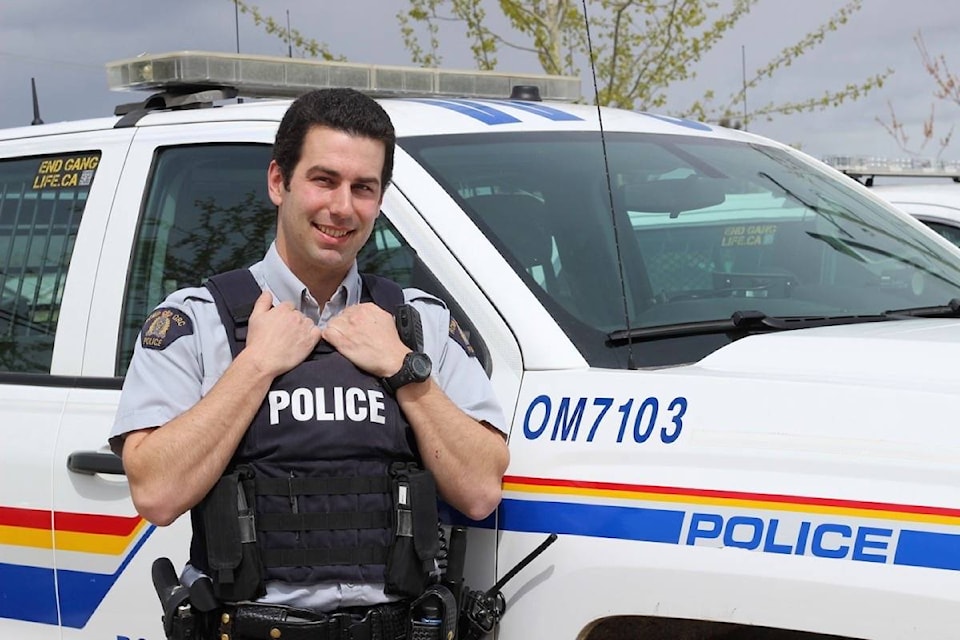When Const. Matt Young walks into the 100 Mile House RCMP Detachment to start his shift, he needs to be ready for anything to happen.
The first thing he does is gather his equipment and put on his uniform. Then he’ll load his vehicle with his duty bag filled with the various tools of the job — forms, tickets, the many trappings he might need to deal with whatever may happen to him that day.
“You’re ready for essentially whatever the day is going to bring you. You never really know,” he says.
RCMP members have to be ready for any number of things. Their day may include anything from simply filling out paperwork and popping by the local hockey game, to attending a murder scene or resolving a domestic dispute. It’s a job with a lot of variety, which is exactly what Young likes about it.
“You are not sitting at a desk all day,” he says. “One day you can have a slower day where you are catching up on all your work and doing paperwork, but the next day you have that all involved file where you are really having to put your brain to work and get into it and piece that puzzle together.”
Young says he generally sets himself up with a plan of what he wants to do during a day — although the chances of being interrupted by a call coming in is quite high.
When someone calls the RCMP detachment or 911, the call taker will take the initial information and give the call a priority rating depending on the type of file. Then it will get dispatched to the officers, either from the office or via the radio.
Officers then can request additional information. Registered firearms, a history of disputes, or previous encounters with police are all taken into consideration.
“It all comes down to going into it with as much information right off the bat so we can be approaching it in a safe manner,” says Young. He says the priorities in attending a scene are officer safety, public safety and the safety of the individuals involved.
Generally, he says, if approaching a residence, officers often just knock on the door; however, and he says this is the exception, if there are other factors such as the involvement of a firearm, RCMP members might take a more tactical approach.
“There’s a lot of communication between us as members because we want to make sure that we’re both on the same page going into a situation and as it is evolving.”
Every scenario an officer deals with — from a car crash to a mischief file or domestic dispute — involves a slightly different game plan, a different number of RCMP members attending, or a different approach.
In cases involving crimes, officers may take pictures, statements and what evidence they can gather from a scene.
They might then make an arrest or take someone back to the station just to keep them from causing more of a disturbance. When police decide to recommend charges to the Crown, this person may either be released with a court date, or taken to a justice to determine whether they should be kept in custody until their first court appearance.
When they arrive back at the station, more work awaits an RCMP member: paperwork.
“The jokes come from a definite degree of truth,” says Young. “Accountability is a major aspect of police work and it’s good to have that aspect of it, but with that comes being much more thorough and much more detailed in report writing.”
All files involve some paperwork, from a general report on the call that came in and how an officer dealt with it, to intensive narrative pieces that include breakdowns for every action taken and piece of evidence seized.
Young says it’s a balancing act to juggle the paperwork he has with active calls coming in. He estimates that on an average day he might spend about half to two-thirds of his time on paperwork and following up on old files and about half to one-third of his day working on new calls and community involvement.
At the end of his day, Young will complete a synopsis of the files he’s dealt with, in case someone needs to check on what happened and then will brief the new shift of officers on what might need to be completed or followed up on. Other days, if he’s on call, he might head home in his uniform with his vehicle.
RCMP members also find a way to wind down after a busy day. Many stop by the gym on their way home and, while Young says he doesn’t find it too difficult to keep a balance between home and work, he says he uses off-roading to unwind.
A day in a life of an RCMP officer is hard to pin down.
“It has a large degree of spontaneous action,” says Young. “You could be sitting and having a coffee during a break and then the big one comes in and you could be running around for the rest of your shift.”
Despite the variety of things that he may deal with on an average day, some things still surprise him. About two weeks ago Young got a call that brought him down to Highway 97 in the middle of town.
“I had to essentially escort a beaver across the highway,” he says. “I’ve never heard of a member having to do that.”
